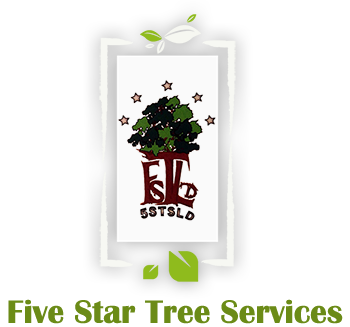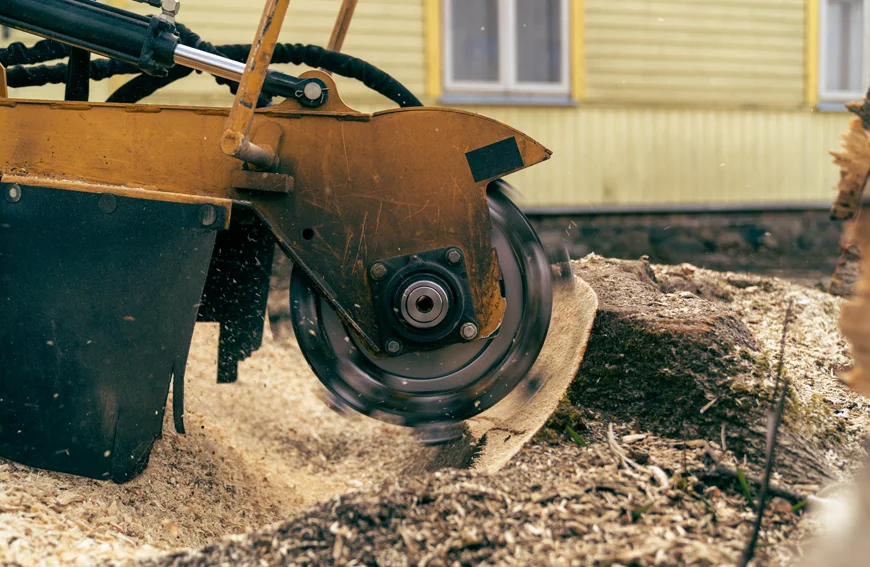Tree removal often leaves behind more than just a bare trunk—stumps linger, disrupting aesthetics, lawn care, and safety. At Five Star Tree Services, we see first-hand how a seemingly small remnant can become an eyesore, a hazard, and a nuisance over time. This guide explores why stump grinding is essential for a healthy, smooth landscape, what the process involves, and how to get it done properly.
Why You Should Consider Stump Grinding
Even after a tree is removed, the stump and root system carry risks:
- Trip hazards & mower damage
A stump sticks out of the ground, making it dangerous for foot traffic, especially in lawns or pathways. Mowers or lawn equipment can also get damaged when striking hidden roots or portions of the stump. - Pest attraction & disease spread
Decaying stumps attract wood-feeding insects like termites, carpenter ants, and beetles. Fungi or disease may also colonize the stump, potentially impacting nearby plants. - Unwanted regrowth
Some species can sprout new shoots (“suckers”) from the stump or roots. Even if the main trunk is gone, new weak stems may emerge. - Slow natural decay
Letting nature take its course means the stump may take many years to fully decompose. During that time, it occupies space and remains a visual distraction. - Landscape flexibility
Removing the visual and physical barrier lets you replant, lawn-seed, install hardscaping, or simply restore a clean, level look to your yard.
Because of these issues, stump grinding is a preferred method—it removes the visible stump below ground level without disturbing surrounding soil excessively.
How Stump Grinding Works: Step-by-Step
- Site inspection and prep
Before grinding, evaluate the area. Look for obstacles, nearby structures, underground utilities, and soil conditions. Clear away rocks, debris, and any overgrowth around the stump that could interfere with the grinder. - Trimming the stump surface
If the stump is tall, it’s often trimmed close to ground level first. This reduces the grinding time by eliminating excess wood before the grinder engages the stump itself. - Choosing the depth
A typical stump grind goes 4–6 inches below the soil surface, which prevents regrowth while leaving enough soil for covering. Larger stumps or areas needing replanting may require deeper grinding (even up to 12–18 inches) depending on root systems and soil conditions. - Grinding process
The stump grinder’s rotating cutting wheel, equipped with carbide teeth, is lowered slowly onto the stump. The operator moves the wheel side to side, taking incremental bites out of the wood. As material is cut, more depth is taken, and sections are ground gradually until desired depth is reached. - Debris cleanup
After grinding, the result is coarse wood chips or mulch. These are collected, raked, or used locally as ground cover or mulch. The leftover void is backfilled with topsoil and leveled to match the surrounding grade. - Restoration & replanting
Once the hole is filled and leveled, new sod, grass seed, or plants can be placed. The area generally recovers well, blending seamlessly into your landscape.
Manual Methods & Alternatives (When Grinding Isn’t Feasible)
- Hand removal
For very small stumps, you can excavate around the stump, cut roots manually, and lever out the stump. It’s labor-intensive and not always effective for large stumps or dense root systems. - Chemical decomposition
Drilling holes into the stump and filling with potassium nitrate or other stump removal products accelerates decay. This method is slower (weeks to months) and limited in control. - Burning or chemical kill
Some opt to burn stumps or use herbicides to kill them. These methods come with safety, legal, or environmental precautions and don’t always remove the wood.
Grinding offers the best balance: speed, safety, minimal disturbance, and effective removal.
Choosing the Right Depth & Equipment
- Stump Diameter & Age
Larger stumps often need deeper grinding to address entrenched root systems and prevent regrowth. - Tree Species & Hardness
Denser hardwoods may require more aggressive cutting or deeper passes. - Soil & Terrain
Rocky or compacted soil might limit depth, while loose soil allows more depth without damaging utilities. - Future Landscaping Plans
If you intend to plant in the same spot, deeper grinding helps ensure the area is clear for new root systems. - Equipment Type
Smaller handheld grinders are suitable for narrow or tight spaces. Larger walk-behind or ride-on grinders are used for bigger stumps.
Experienced professionals assess all these factors to determine the optimal grinding depth and approach for your property.
Safety Considerations & Best Practices
- Always wear protective equipment: eye protection, gloves, ear protection, steel-toed boots.
- Mark and confirm underground utilities before any deep grinding.
- Maintain a clear work zone—keep pets, children, and bystanders at a safe distance.
- Remove rocks, roots, and debris before turning on the grinder. These can bounce off or damage equipment.
- Use the grinder steadily, avoid forcing it, and let the machine do the work at safe speeds.
- Proper cleanup—remove chips, level soil, and restore topsoil to prevent trip hazards.
Why Relying on Pros Is Worth It
Stump grinding might seem like a doable DIY task, but there are many reasons to hire a professional arborist or experienced tree service:
- They have proper machines and attachments suited for varying stump sizes and terrain.
- Pros understand safe operations and precise depth control to avoid accidental damage to nearby structures or utilities.
- They handle the cleanup, disposal, and restoration, saving you time and effort.
- Their expertise ensures no regrowth or hidden root issues remain.
- They carry liability insurance and industry knowledge to protect your property and safety.
At Five Star Tree Services, we combine experience, safety protocols, and efficient machinery to deliver clean stump removal without disrupting your yard.
When Is Stump Grinding Essential?
Consider stump grinding when:
- You want to reclaim lawn space and maintain a neat, safe yard
- The stump is interfering with mowing or landscaping
- There’s risk of pest infestation or disease spreading
- You plan to plant or build in the same spot
- The stump is unsightly or causing visual disruption
Delaying stump removal invites problems. Act sooner than later for a healthier, more usable outdoor space.
Cost Factors & What to Expect
Several variables influence stump grinding cost: stump size (diameter), how deep you want to grind, accessibility of the location, number of stumps, cleanup scope, and soil conditions. On average, professional services charge per inch of stump width plus additional labor. Because Five Star Tree Services optimizes project planning, clients often receive transparent quotes with no hidden fees.
Aftercare & Long-Term Success
To support new growth or lawn recovery:
- Level and compact the soil, mix in quality topsoil.
- Seed or sodding: choose grass compatible with your climate and soil.
- Water properly to help grass settle.
- Monitor for new sucker growth — any sprouts from remaining roots should be removed immediately.
- Mulch or integrate leftover wood chips into garden beds for nutrient recycling.
Over time, the ground stabilizes and blends with surrounding terrain.
In every landscape, the removal of old stumps marks a fresh start. At Five Star Tree Services, we’re committed to delivering clean, safe, and effective stump grinding that restores beauty and function to your outdoor spaces. When you want dependable results, minimal disruption, and a yard you’re proud of, our team is here to make it happen.


